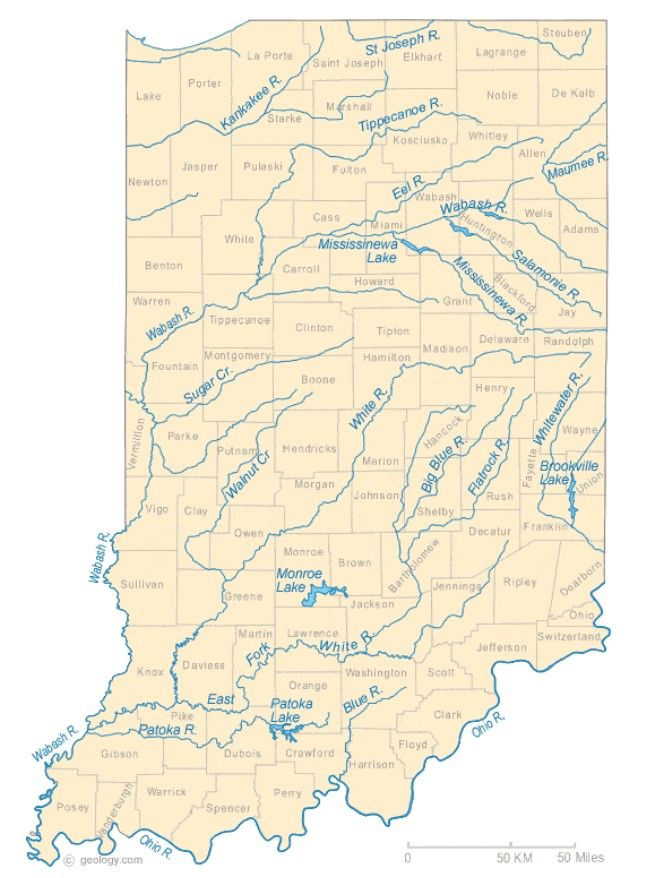Indiana, the 38th largest state in the US, is home to a diverse array of waterways that crisscross its landscape. From the mighty Ohio River that forms the southern border to the smaller streams and creeks that feed into the Great Lakes, Indiana’s rivers offer a wealth of opportunities for outdoor recreation, wildlife watching, and environmental exploration. In this essay, we will provide a detailed overview of the major rivers in Indiana, their origins, paths, and characteristics.
Indiana Rivers Map

Click Here to Download
Ohio River
The Ohio River is the most significant river in Indiana and forms the state’s southern border with Kentucky. It stretches for 981 miles from Pittsburgh, Pennsylvania, to Cairo, Illinois, and is a major artery for commerce and transportation in the region. The river is navigable for most of its length, and several ports along the Indiana side of the river handle a variety of goods, including coal, grain, and chemicals.
Wabash River
The Wabash River is the longest free-flowing river in the eastern United States and is the primary waterway of northern Indiana. The river stretches for 475 miles from its headwaters in western Ohio to its confluence with the Ohio River near the town of Mount Vernon, Indiana. The Wabash River is a popular destination for fishing, boating, and camping, and its banks are home to a variety of wildlife, including beavers, otters, and bald eagles.
White River
The White River is the largest river in Indiana and stretches for 362 miles from its headwaters in Randolph County to its confluence with the Wabash River near the town of Mount Carmel. The river is a popular destination for canoeing, kayaking, and fishing, and its banks are home to a variety of plant and animal species. The White River has a long history of industrial and agricultural use, and efforts are currently underway to improve water quality and protect the river’s ecosystem.
Kankakee River
The Kankakee River is a 133-mile-long river that flows through northwestern Indiana and northeastern Illinois. The river is known for its scenic beauty and is a popular destination for canoeing, kayaking, and fishing. The Kankakee River has a diverse ecosystem, and its banks are home to a variety of plant and animal species, including several endangered species. Efforts are currently underway to restore the river’s wetlands and improve water quality.
Maumee River
The Maumee River is a 137-mile-long river that flows through northeastern Indiana and northwestern Ohio. The river is a major tributary of Lake Erie and is a popular destination for fishing and boating. The Maumee River has a diverse ecosystem and is home to a variety of plant and animal species, including several endangered species. Efforts are currently underway to reduce pollution and improve water quality in the river.
Tippecanoe River
The Tippecanoe River is a 182-mile-long river that flows through northern Indiana. The river is a popular destination for fishing, boating, and camping, and its banks are home to a variety of plant and animal species, including several rare and endangered species. The Tippecanoe River has a long history of industrial and agricultural use, and efforts are currently underway to restore wetlands and improve water quality.
St. Joseph River
The St. Joseph River is a 206-mile-long river that flows through northern Indiana and southern Michigan. The river is a popular destination for fishing, boating, and camping, and its banks are home to a variety of plant and animal species, including several rare and endangered species. The St. Joseph River has a long history of industrial and agricultural use, and efforts are currently underway to improve water quality and reduce pollution in the river.
Eel River
The Eel River is a 110-mile-long river that flows through north-central Indiana. The river is a popular destination for fishing, and its banks are home to a variety of plant and animal species, including several rare and endangered species. The Eel River has a long history of agricultural and industrial use, and efforts are currently underway to restore the river’s ecosystem and improve water quality.
Mississinewa River
The Mississinewa River is a 110-mile-long river that flows through northeastern Indiana. The river is a popular destination for fishing and boating, and its banks are home to a variety of plant and animal species, including several rare and endangered species. The Mississinewa River has a long history of industrial and agricultural use, and efforts are currently underway to improve water quality and reduce pollution in the river.
Blue River
The Blue River is a 65-mile-long river that flows through southern Indiana. The river is a popular destination for fishing and canoeing, and its banks are home to a variety of plant and animal species, including several rare and endangered species. The Blue River has a long history of agricultural and industrial use, and efforts are currently underway to restore the river’s ecosystem and improve water quality.
Salamonie River
The Salamonie River is a 85-mile-long river that flows through northeastern Indiana. The river is a popular destination for fishing and boating, and its banks are home to a variety of plant and animal species, including several rare and endangered species. The Salamonie River has a long history of industrial and agricultural use, and efforts are currently underway to restore the river’s ecosystem and improve water quality.
Indiana’s rivers offer a wealth of opportunities for outdoor recreation, wildlife watching, and environmental exploration. Each river has its unique characteristics, ecosystems, and histories of industrial and agricultural use. However, many of the rivers in Indiana have suffered from pollution, habitat loss, and other environmental issues over the years. Efforts are currently underway to restore these rivers’ ecosystems, improve water quality, and protect the plant and animal species that call them home. By educating ourselves about the rivers in our state and taking action to protect them, we can ensure that future generations can enjoy these valuable resources for years to come.


